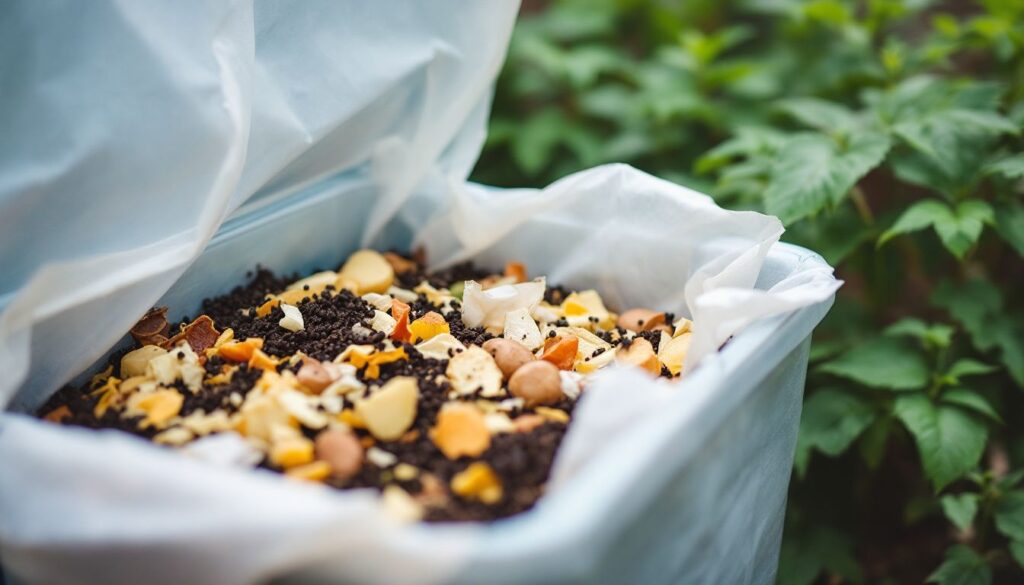Are you tired of buying costly plant food when you could make rich soil at home? We’ve been wrestling with this same problem and spent years watching how worms turn kitchen scraps into garden gold.
Vermicompost is made up of worm poo, bits of plant matter, and millions of tiny helpers that work as a team to feed your plants. Our guide will show you just what goes into this natural plant food and how it makes your garden thrive.
Keep reading to turn your waste into wealth for your plants. It’s quite brilliant, really.
The Basics of Vermicompost

Vermicompost is a rich, dark soil made by worms that eat kitchen scraps and garden waste. We create this natural fertiliser by letting special worms break down organic matter into a nutrient-packed plant food.
Definition and Overview
Worm composting, also known as vermicomposting, turns organic waste into rich soil through the work of special worms. We use this method on both small kitchen bins and large two-acre farms.
Unlike normal composting that relies on fungi and microbes, vermicomposting uses worms like Eisenia fetida (red wigglers or tiger worms) to break down waste. This process creates three useful products: the worms themselves, worm castings (the compost), and vermicompost tea.
Many gardeners prize these castings as top-quality soil amendments for plants.
Importance of Vermicompost in Organic Farming
Vermicompost plays a vital role in organic farming as a top soil amendment. We see huge benefits from using this nutrient-rich material in our gardens and farms. It helps us divert organic waste from landfills and cuts trash collection fees.
The process works fast too – vermicompost can be ready in just 8-12 weeks, while normal compost takes 6-9 months. This quick turnaround makes it perfect for farmers who need to enrich their soil often throughout the growing season.
Worms are the unsung heroes of sustainable agriculture, turning waste into garden gold.
The magic happens as worms eat more than half their body weight each day. They create castings full of nutrients that plants love. We can mix vermicompost with potting soil (10% by volume) or add it straight to garden beds.
Plants grow stronger and healthier with this natural boost. For organic farmers, this means better crops without chemical fertilizers. The soil gets richer, holds more water, and supports more helpful microbes – all keys to sustainable farming success.
Key Components of Vermicompost
Vermicompost contains several key parts that work together to create a powerful soil booster. These components break down through natural processes to form a rich, dark material full of plant nutrients.
Earthworm Castings
Earthworm castings form the heart of vermicompost. These tiny pellets are simply worm poo that remains after worms eat through organic waste. We find these castings packed with nutrients that plants love.
The digestion process transforms simple organic matter into stable material that enriches soil perfectly. Our vermiculture systems rely on the amazing ability of worms to process waste quickly.
Worm reproduction rates make this system even more valuable. These helpful creatures double their biomass every 60 days, creating a sustainable cycle. We can harvest up to 10% of this biomass weekly without harming our worm population.
The castings contain concentrated nutrients from the organic matter recycling process. This natural soil enrichment process creates nutrient-rich compost that gardeners prize for its quality.
Organic Matter and Food Scraps
Organic matter forms the base of all vermicompost. We feed our worms with fruits, vegetables, grains, coffee grounds, paper, and manure. These materials break down quickly and create nutrient-rich castings.
Our worms love these food scraps but can’t eat everything. Meat, dairy, oils, and citrus scraps must stay out of worm bins as they’re toxic to the worms.
Food scraps need proper management in the bin. Primary vermicomposting requires small, frequent feedings to prevent overheating. Secondary vermicomposting uses pre-composted materials broken down by microorganisms first.
This method allows thicker layers of food and less frequent feeding times. The type of organic matter directly affects the final quality of your vermicompost. Next, we’ll explore how these materials transform into valuable worm castings through natural processes.
The secret to great vermicompost lies in what you feed your worms. Good inputs create outstanding outputs for your garden.
Microorganisms and Beneficial Bacteria
We find countless tiny helpers in vermicompost that most people can’t see. These microorganisms play a key role in breaking down organic matter into rich soil food. Bacteria, fungi, and other small life forms work with worms to turn waste into plant gold.
The aerobic process needs oxygen to work well, and the worms help air flow through the compost pile. This team effort creates the perfect mix for plants to thrive.
Our garden soil gets a big boost from these helpful microbes. They create a food web in the compost that keeps working even after we add it to our gardens. These tiny life forms help plants take up nutrients more easily.
The mix of microbes also fights off harmful bugs that might hurt plants. Next, we’ll look at the main nutrients found in vermicompost and how they feed your plants.
Nutritional Composition of Vermicompost
Vermicompost is packed with essential nutrients that plants need to grow strong and healthy. It contains higher levels of NPK (nitrogen, phosphorus, and potassium) than normal garden soil, making it a top choice for organic gardeners.
Nitrogen, Phosphorus, and Potassium (NPK)
The NPK content serves as the backbone of vermicompost’s effectiveness. These three nutrients play vital roles in plant development and growth. Our tests show that properly made vermicompost contains balanced levels of these essential nutrients.
| Nutrient | Typical Content in Vermicompost | Plant Benefits |
|---|---|---|
| Nitrogen (N) | 1.5-2.5% | Promotes leaf growth and green colour |
| Phosphorus (P) | 1.0-2.0% | Supports root development and flowering |
| Potassium (K) | 1.0-2.5% | Enhances disease resistance and fruit quality |
NPK values may vary based on the materials used in making the compost. Each nutrient works together to create a complete feeding system for plants. We’ve found that the reddish-brown vermicompost tea contains concentrated amounts of these nutrients in liquid form. Many gardeners apply this nutrient-rich liquid directly to plants for quick absorption.
Micronutrients like Zinc and Iron
Vermicompost contains essential micronutrients that plants need for healthy growth. We find these nutrients play vital roles in plant development and soil health. These tiny but mighty elements make a big difference in your garden.
| Micronutrient | Function in Plants | Benefits in Vermicompost |
|---|---|---|
| Zinc | Helps in protein synthesis and growth hormone production | Improves seed formation and plant maturation |
| Iron | Essential for chlorophyll production | Prevents yellowing of leaves and promotes greener foliage |
| Manganese | Aids in photosynthesis | Enhances plant resistance to disease |
| Copper | Supports enzyme activities | Strengthens stems and prevents wilting |
Water levels in the vermicomposting system directly affect micronutrient concentration. Adding more water can dilute nutrients, while less water creates a more concentrated mix. Our tests show proper moisture management results in ideal micronutrient levels for plant uptake.
Conclusion
Worm castings form the heart of rich vermicompost, packed with good stuff for plants. Our gardens thrive when we add this mix of broken-down scraps and worm poop to the soil. The tiny bugs and germs in vermicompost help plants get what they need to grow strong.
You can make this black gold at home with just some worms, food scraps, and a bit of care. This simple process turns waste into wealth for your garden while helping our planet stay green.




